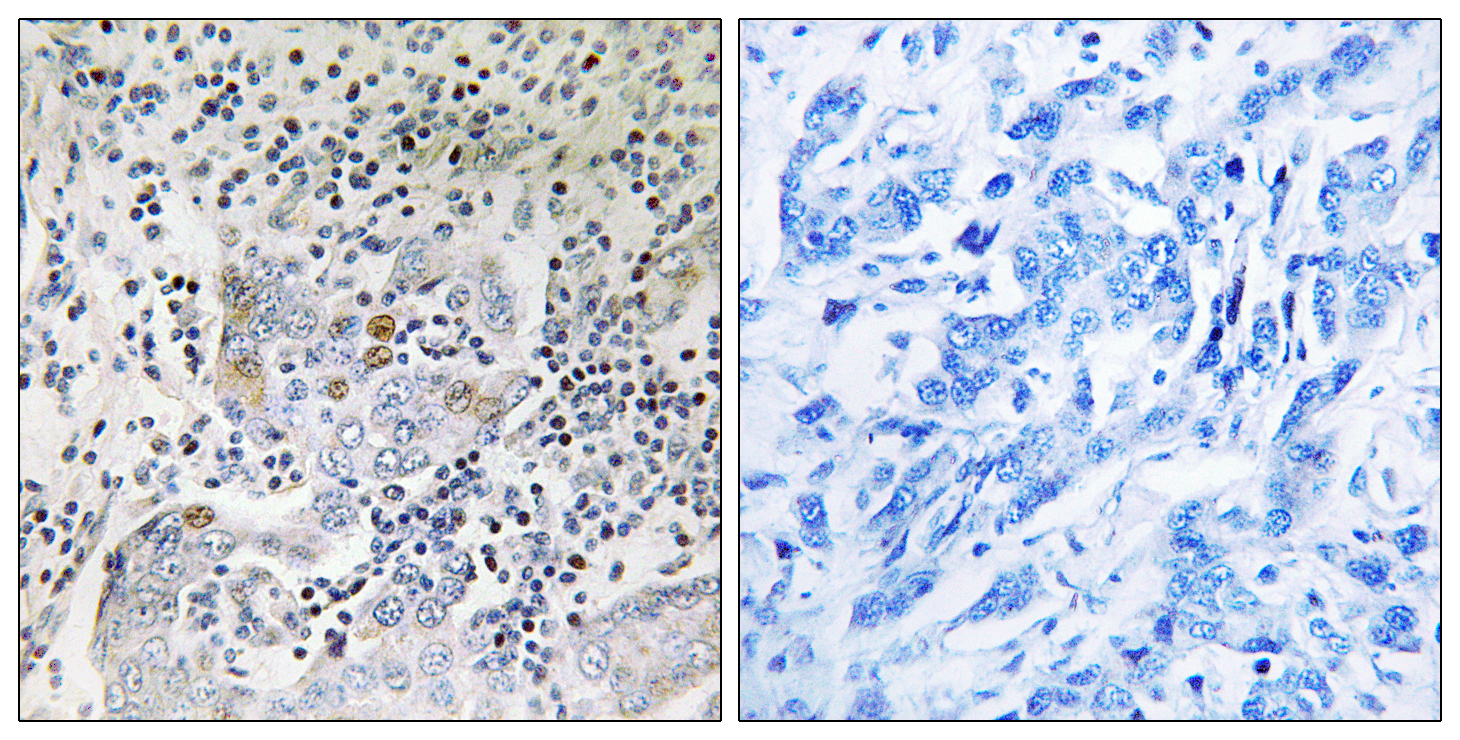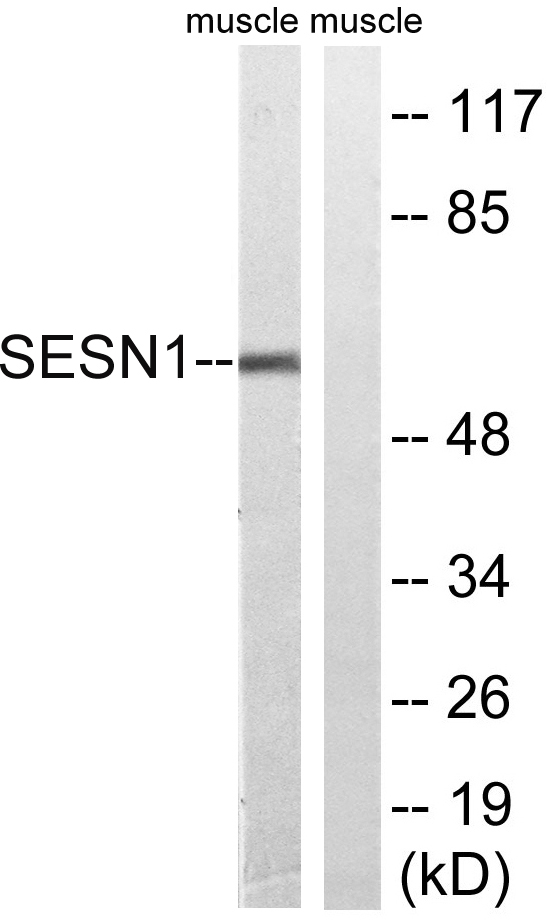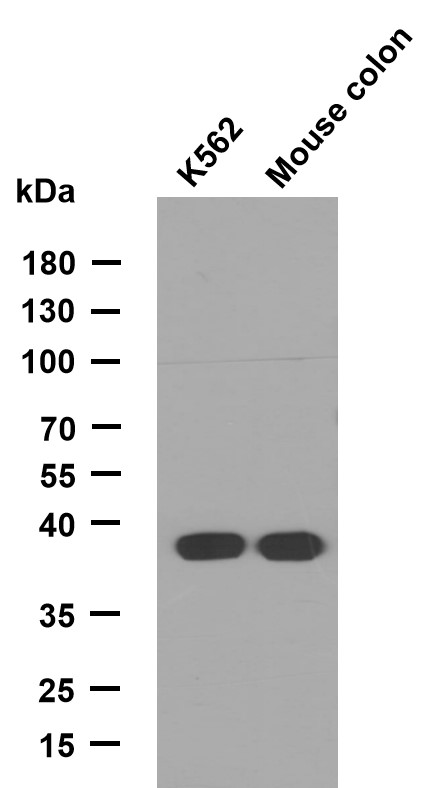PA26 Polyclonal Antibody
- Catalog No.:YT3562
- Applications:WB;IHC;IF;ELISA
- Reactivity:Human;Mouse;Rat
- Target:
- PA26
- Fields:
- >>p53 signaling pathway;>>Longevity regulating pathway
- Gene Name:
- SESN1
- Protein Name:
- Sestrin-1
- Human Gene Id:
- 27244
- Human Swiss Prot No:
- Q9Y6P5
- Mouse Gene Id:
- 140742
- Mouse Swiss Prot No:
- P58006
- Immunogen:
- The antiserum was produced against synthesized peptide derived from human SESN1. AA range:271-320
- Specificity:
- PA26 Polyclonal Antibody detects endogenous levels of PA26 protein.
- Formulation:
- Liquid in PBS containing 50% glycerol, 0.5% BSA and 0.02% sodium azide.
- Source:
- Polyclonal, Rabbit,IgG
- Dilution:
- WB 1:500 - 1:2000. IHC 1:100 - 1:300. ELISA: 1:20000.. IF 1:50-200
- Purification:
- The antibody was affinity-purified from rabbit antiserum by affinity-chromatography using epitope-specific immunogen.
- Concentration:
- 1 mg/ml
- Storage Stability:
- -15°C to -25°C/1 year(Do not lower than -25°C)
- Other Name:
- SESN1;PA26;SEST1;Sestrin-1;p53-regulated protein PA26
- Observed Band(KD):
- 57kD
- Background:
- This gene encodes a member of the sestrin family. Sestrins are induced by the p53 tumor suppressor protein and play a role in the cellular response to DNA damage and oxidative stress. The encoded protein mediates p53 inhibition of cell growth by activating AMP-activated protein kinase, which results in the inhibition of the mammalian target of rapamycin protein. The encoded protein also plays a critical role in antioxidant defense by regenerating overoxidized peroxiredoxins, and the expression of this gene is a potential marker for exposure to radiation. Alternatively spliced transcript variants encoding multiple isoforms have been observed for this gene. [provided by RefSeq, Dec 2010],
- Function:
- disease:Defects in SESN1 may be involved in heterotaxia. Heterotaxia is an aetiologically heterogeneous condition caused by an abnormal left-right axis formation, resulting in reversed left-right polarity of one or more organ systems.,function:Involved in the reduction of peroxiredoxins. May also be regulator of cellular growth.,induction:Isoforms T2 and isoform T3 are induced by genotoxic stress (UV, gamma-irradiation and cytotoxic drugs) in a p53-dependent manner. Isoform T1 is not induced by p53.,PTM:Phosphorylated upon DNA damage, probably by ATM or ATR.,similarity:Belongs to the sestrin family.,tissue specificity:Widely expressed.,
- Subcellular Location:
- Nucleus . Cytoplasm .
- Expression:
- Widely expressed.
- June 19-2018
- WESTERN IMMUNOBLOTTING PROTOCOL
- June 19-2018
- IMMUNOHISTOCHEMISTRY-PARAFFIN PROTOCOL
- June 19-2018
- IMMUNOFLUORESCENCE PROTOCOL
- September 08-2020
- FLOW-CYTOMEYRT-PROTOCOL
- May 20-2022
- Cell-Based ELISA│解您多样本WB检测之困扰
- July 13-2018
- CELL-BASED-ELISA-PROTOCOL-FOR-ACETYL-PROTEIN
- July 13-2018
- CELL-BASED-ELISA-PROTOCOL-FOR-PHOSPHO-PROTEIN
- July 13-2018
- Antibody-FAQs
- Products Images

- Immunohistochemistry analysis of paraffin-embedded human breast carcinoma tissue, using SESN1 Antibody. The picture on the right is blocked with the synthesized peptide.

- Western blot analysis of lysates from rat muscle cells, using SESN1 Antibody. The lane on the right is blocked with the synthesized peptide.



